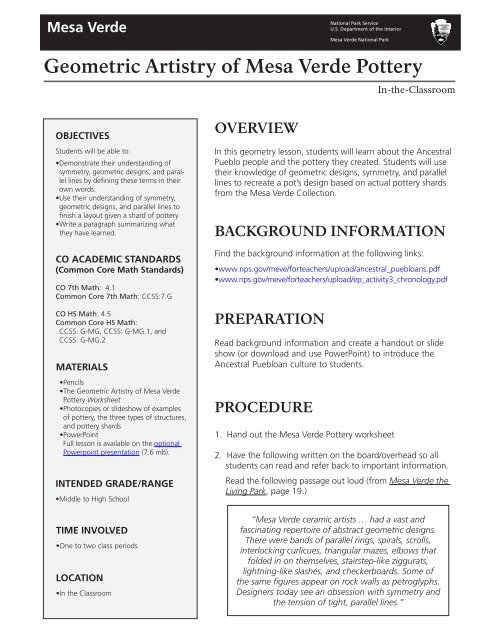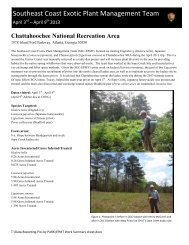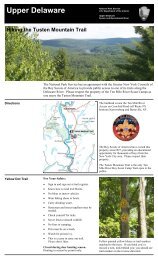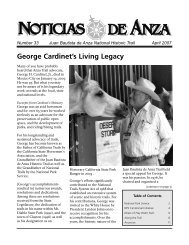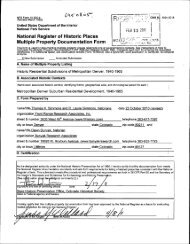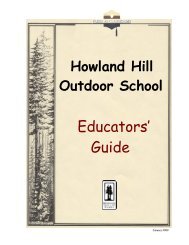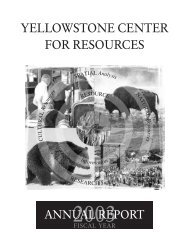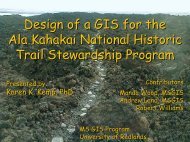Geometric Artistry of Mesa Verde Pottery - National Park Service
Geometric Artistry of Mesa Verde Pottery - National Park Service
Geometric Artistry of Mesa Verde Pottery - National Park Service
You also want an ePaper? Increase the reach of your titles
YUMPU automatically turns print PDFs into web optimized ePapers that Google loves.
<strong>Mesa</strong> <strong>Verde</strong><br />
<strong>National</strong> <strong>Park</strong> <strong>Service</strong><br />
U.S. Department <strong>of</strong> the Interior<br />
<strong>Mesa</strong> <strong>Verde</strong> <strong>National</strong> <strong>Park</strong><br />
<strong>Geometric</strong> <strong>Artistry</strong> <strong>of</strong> <strong>Mesa</strong> <strong>Verde</strong> <strong>Pottery</strong><br />
In-the-Classroom<br />
OBJECTIVES<br />
Students will be able to:<br />
•Demonstrate their understanding <strong>of</strong><br />
symmetry, geometric designs, and parallel<br />
lines by defining these terms in their<br />
own words.<br />
•Use their understanding <strong>of</strong> symmetry,<br />
geometric designs, and parallel lines to<br />
finish a layout given a shard <strong>of</strong> pottery<br />
•Write a paragraph summarizing what<br />
they have learned.<br />
CO ACADEMIC STANDARDS<br />
(Common Core Math Standards)<br />
CO 7th Math: 4.1<br />
Common Core 7th Math: CCSS:7.G<br />
CO HS Math: 4.5<br />
Common Core HS Math:<br />
CCSS: G-MG, CCSS: G-MG.1, and<br />
CCSS: G-MG.2<br />
MATERIALS<br />
•Pencils<br />
•The <strong>Geometric</strong> <strong>Artistry</strong> <strong>of</strong> <strong>Mesa</strong> <strong>Verde</strong><br />
<strong>Pottery</strong> Worksheet<br />
•Photocopies or slideshow <strong>of</strong> examples<br />
<strong>of</strong> pottery, the three types <strong>of</strong> structures,<br />
and pottery shards<br />
•PowerPoint<br />
Full lesson is available on the optional<br />
Powerpoint presentation (7.6 mb).<br />
INTENDED GRADE/RANGE<br />
•Middle to High School<br />
TIME INVOLVED<br />
•One to two class periods<br />
LOCATION<br />
•In the Classroom<br />
OVERVIEW<br />
In this geometry lesson, students will learn about the Ancestral<br />
Pueblo people and the pottery they created. Students will use<br />
their knowledge <strong>of</strong> geometric designs, symmetry, and parallel<br />
lines to recreate a pot’s design based on actual pottery shards<br />
from the <strong>Mesa</strong> <strong>Verde</strong> Collection.<br />
BACKGROUND INFORMATION<br />
Find the background information at the following links:<br />
•www.nps.gov/meve/forteachers/upload/ancestral_puebloans.pdf<br />
•www.nps.gov/meve/forteachers/upload/ep_activity3_chronology.pdf<br />
PREPARATION<br />
Read background information and create a handout or slide<br />
show (or download and use PowerPoint) to introduce the<br />
Ancestral Puebloan culture to students.<br />
PROCEDURE<br />
1. Hand out the <strong>Mesa</strong> <strong>Verde</strong> <strong>Pottery</strong> worksheet<br />
2. Have the following written on the board/overhead so all<br />
students can read and refer back to important information.<br />
Read the following passage out loud (from <strong>Mesa</strong> <strong>Verde</strong> the<br />
Living <strong>Park</strong>, page 19.)<br />
“<strong>Mesa</strong> <strong>Verde</strong> ceramic artists … had a vast and<br />
fascinating repertoire <strong>of</strong> abstract geometric designs.<br />
There were bands <strong>of</strong> parallel rings, spirals, scrolls,<br />
interlocking curlicues, triangular mazes, elbows that<br />
folded in on themselves, stairstep-like ziggurats,<br />
lightning-like slashes, and checkerboards. Some <strong>of</strong><br />
the same figures appear on rock walls as petroglyphs.<br />
Designers today see an obsession with symmetry and<br />
the tension <strong>of</strong> tight, parallel lines.”
3. Discuss key words or math phrases from the paragraph. Give definitions and have students write in their<br />
own words their definitions <strong>of</strong> geometric designs, parallel lines, and symmetry.<br />
4. Have students do a quick sketch <strong>of</strong> a pot design on their handout based on the information from the<br />
<strong>Mesa</strong> <strong>Verde</strong> the Living <strong>Park</strong> passage.<br />
5. Show examples <strong>of</strong> pottery (Appendix A) and ask students to compare their sketch to the Ancestral<br />
Puebloan pots by writing some similarities or differences on their worksheet.<br />
6. Have students brainstorm why Ancestral Puebloans used geometric designs. Ask students if they have any<br />
geometric designs that are important to them.<br />
7. Using the background information, explain about the Ancestral Puebloans’ 700 year history at <strong>Mesa</strong> <strong>Verde</strong>.<br />
Or use the following (also on optional powerpoint):<br />
Pithouses<br />
•Around A.D. 550 the first Ancestral Pueblo people settled in the <strong>Mesa</strong> <strong>Verde</strong> area. They are known<br />
as Basketmakers for their skill in crafting baskets.<br />
•Instead <strong>of</strong> being nomadic, the Basketmakers started farming and building permanent structures<br />
called pithouses.<br />
•They began making pottery and acquired the bow and arrow.<br />
•Their food included corn, beans, squash, nuts, fruits, rabbit, deer and turkey.<br />
Pueblos<br />
•Around A.D. 750 the buildings started to evolve with population expansion.<br />
–Along with pithouses, the Ancestral Pueblo people created structures above ground using poles<br />
and mud. These new structures were placed side by side in curving rows to create villages.<br />
–Masonry structures, using sandstone blocks, were developed by A.D. 1000. This skill allowed<br />
multi- story housing units.<br />
–Pithouses began evolving into kivas. These new underground rooms became a ceremonial site,<br />
meeting space, and occasional winter residence.<br />
•The use <strong>of</strong> pottery increased as they created many different types such as ladles, mugs, bowls, lidded<br />
jars, and canteens. Many were painted with organic or mineral based paint using brushes made<br />
from yucca.<br />
Cliff Dwellings<br />
•Around A.D. 1150 many people began moving from their homes on the mesa into the cliff alcoves.<br />
–They started building larger, more complex, densely packed, multistory stone and mortar pueblos.<br />
–Rooms usually housed two or three people. There were also rooms used for storage.<br />
•The flat-ro<strong>of</strong>ed kivas were built in front <strong>of</strong> rooms. This created a courtyard, an area for daily routines.<br />
•<strong>Pottery</strong> also changed from simple designs to complicated black geometric designs painted on white<br />
backgrounds. Their pottery had progressed to a point where some researchers consider it to be the<br />
“highest artistic expression” <strong>of</strong> the culture.<br />
Leaving <strong>Mesa</strong> <strong>Verde</strong><br />
•Sometime after A.D. 1250 the Ancestral Pueblo people started to leave the <strong>Mesa</strong> <strong>Verde</strong> area. By<br />
A.D. 1300, everyone had moved away, eventually settling along the mesas, rivers, and streams to<br />
the south where their descendants live today.<br />
•No one knows exactly why they left, but some hypotheses include: drought, social or political<br />
problems, depletion <strong>of</strong> natural resources, religious reasons, or a desire for a change.<br />
<strong>Mesa</strong> <strong>Verde</strong> <strong>National</strong> <strong>Park</strong>: <strong>Geometric</strong> <strong>Artistry</strong> <strong>of</strong> <strong>Mesa</strong> <strong>Verde</strong> <strong>Pottery</strong> 2
8. Show students the pictures <strong>of</strong> pottery shards (Appendix C). Have them choose a shard, then try to<br />
recreate the rest <strong>of</strong> the pot’s design on their worksheet based on their knowledge <strong>of</strong> symmetry, geometric<br />
designs, and parallel lines.<br />
a. There are three levels <strong>of</strong> difficulty from which to choose: Easy, Hard, and Challenging<br />
b. Students can work in groups or individually<br />
9. When students are finished, have them complete questions 6 and 7 on the worksheet and turn in their<br />
work.<br />
ASSESSMENT<br />
Collect worksheets when students are finished with the activity. Assess student answers on key words, their<br />
interpretation <strong>of</strong> the pottery shard, their paragraph about what they have learned, and reflection about<br />
completing their design.<br />
COLORADO COMMON CORE) ACADEMIC<br />
MATH STANDARDS<br />
These are some <strong>of</strong> the standards that are covered with this activity. You may find additional standards<br />
relevant to your grade level and objectives.<br />
STANDARD 4: Shape, Dimension, and <strong>Geometric</strong> Relationships<br />
Middle School<br />
1. Modeling geometric figures and relationships leads to informal spatial reasoning and pro<strong>of</strong>.<br />
a. Draw, construct, and describe geometrical figures and describe the relationships between<br />
them. (CCSS: 7.G)<br />
High School<br />
5. Objects in the real world can be modeled using geometric concepts.<br />
a. Apply geometric concepts in modeling situations. (CCSS: G-MG)<br />
i. Use geometric shapes, their measures and their properties to describe objects. (CCSS: G-MG.1)<br />
iii. Apply geometric methods to solve design problems. (CCSS: G-MG.3)<br />
<strong>Mesa</strong> <strong>Verde</strong> <strong>National</strong> <strong>Park</strong>: <strong>Geometric</strong> <strong>Artistry</strong> <strong>of</strong> <strong>Mesa</strong> <strong>Verde</strong> <strong>Pottery</strong> 3
<strong>Mesa</strong> <strong>Verde</strong><br />
<strong>National</strong> <strong>Park</strong> <strong>Service</strong><br />
U.S. Department <strong>of</strong> the Interior<br />
<strong>Mesa</strong> <strong>Verde</strong> <strong>National</strong> <strong>Park</strong><br />
Name___________________________ Date________ Period______<br />
The <strong>Geometric</strong> <strong>Artistry</strong> <strong>of</strong> <strong>Mesa</strong> <strong>Verde</strong> <strong>Pottery</strong> Worksheet<br />
1. Define the following terms in your own words<br />
a. <strong>Geometric</strong> Designs<br />
b. Parallel Lines<br />
c. Symmetry<br />
2. Draw a quick sketch <strong>of</strong> a bowl based on the passage from <strong>Mesa</strong> <strong>Verde</strong> a Living <strong>Park</strong>.<br />
3. What were some similarities or differences in your sketch to the examples shown?<br />
4. Why do you think they used geometric designs? Do you have any geometric designs that are<br />
important to you?<br />
<strong>Mesa</strong> <strong>Verde</strong> <strong>National</strong> <strong>Park</strong>: <strong>Geometric</strong> <strong>Artistry</strong> <strong>of</strong> <strong>Mesa</strong> <strong>Verde</strong> <strong>Pottery</strong> Warksheet (page 1 <strong>of</strong> 2) 4
5. Using the pottery shard shown and your understanding <strong>of</strong> symmetry, parallel lines, and geometric<br />
designs, complete (to the best <strong>of</strong> your ability) what the design on the whole pot might have looked like.<br />
Circle what level your shard is: Easy Hard Challenging<br />
6. Write a paragraph about what you learned about pottery and the people who created it. Describe two<br />
things you found interesting about the Ancestral Puebloans.<br />
7. Was it easy or hard to finish the designs started by the Ancestral Puebloans? Explain your answer.<br />
<strong>Mesa</strong> <strong>Verde</strong> <strong>National</strong> <strong>Park</strong>: <strong>Geometric</strong> <strong>Artistry</strong> <strong>of</strong> <strong>Mesa</strong> <strong>Verde</strong> <strong>Pottery</strong> Warksheet (page 2 <strong>of</strong> 2) 5
APPENDIX A: Examples <strong>of</strong> <strong>Pottery</strong><br />
<strong>Mesa</strong> <strong>Verde</strong> <strong>National</strong> <strong>Park</strong>: <strong>Geometric</strong> <strong>Artistry</strong> <strong>of</strong> <strong>Mesa</strong> <strong>Verde</strong> <strong>Pottery</strong> 6
APPENDIX B: Types <strong>of</strong> Structures<br />
Pithouse<br />
Pueblo<br />
<strong>Mesa</strong> <strong>Verde</strong> <strong>National</strong> <strong>Park</strong>: <strong>Geometric</strong> <strong>Artistry</strong> <strong>of</strong> <strong>Mesa</strong> <strong>Verde</strong> <strong>Pottery</strong> 7
Cliff Dwelling<br />
<strong>Mesa</strong> <strong>Verde</strong> <strong>National</strong> <strong>Park</strong>: <strong>Geometric</strong> <strong>Artistry</strong> <strong>of</strong> <strong>Mesa</strong> <strong>Verde</strong> <strong>Pottery</strong> 8
APPENDIX C: <strong>Pottery</strong> Shards (for worksheet)<br />
Easy Shard 1<br />
Easy Shard 2<br />
<strong>Mesa</strong> <strong>Verde</strong> <strong>National</strong> <strong>Park</strong>: <strong>Geometric</strong> <strong>Artistry</strong> <strong>of</strong> <strong>Mesa</strong> <strong>Verde</strong> <strong>Pottery</strong> 9
Hard Shard 1<br />
Hard Shard 2<br />
<strong>Mesa</strong> <strong>Verde</strong> <strong>National</strong> <strong>Park</strong>: <strong>Geometric</strong> <strong>Artistry</strong> <strong>of</strong> <strong>Mesa</strong> <strong>Verde</strong> <strong>Pottery</strong> 10
Challenging Shard 1<br />
Challenging Shard 2<br />
<strong>Mesa</strong> <strong>Verde</strong> <strong>National</strong> <strong>Park</strong>: <strong>Geometric</strong> <strong>Artistry</strong> <strong>of</strong> <strong>Mesa</strong> <strong>Verde</strong> <strong>Pottery</strong> 11


